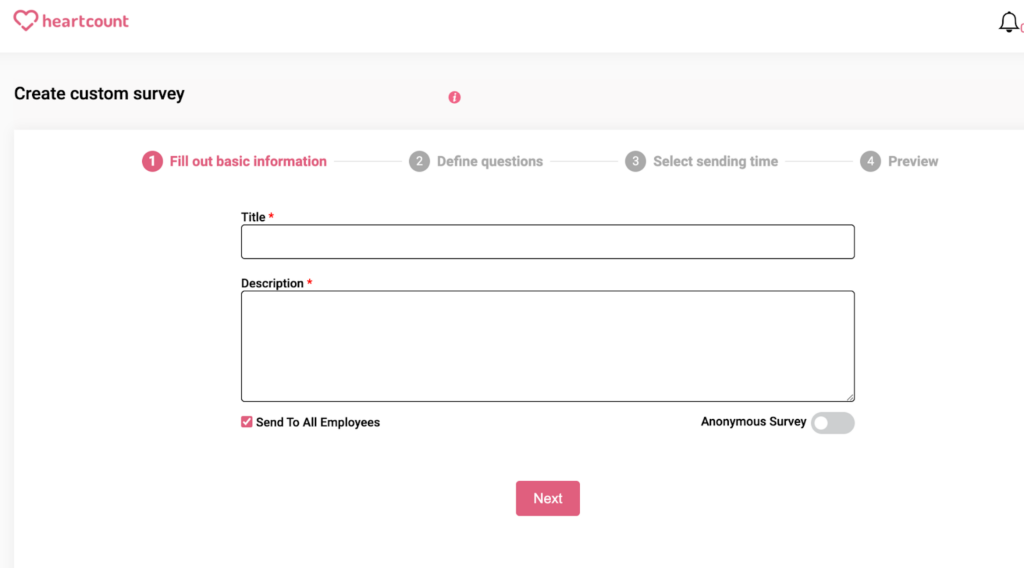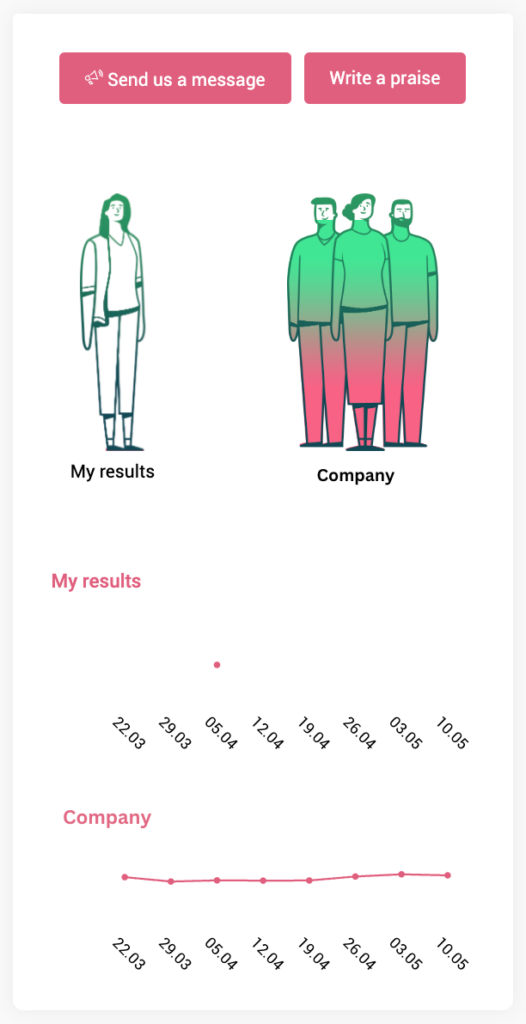Employee experience in 2025: 9 trends to watch

 10 minute read
10 minute read
Inflation, recession, and the threat of a potential downturn “are casting a shadow” over a seemingly strong labor market—it’s actually been difficult both for job seekers and employers looking to stabilize hiring.
As we hit the halfway point of 2024, new trends that will shape the employee experience in 2025 are starting to pop up. Why does this matter?
With the future of talent acquisition uncertain, a safe bet for most companies is to focus on the employee experience (EX). Today’s workers, especially newer generations, know exactly what they want and are ready to commit to companies that meet their expectations.
That’s why, now more than ever, improving the employee experience is key to retaining talents and staying competitive.
This article dives into the future of the modern workplace and explains nine employee experience trends that will shape it during 2025.
Employee experience in 2025: 9 trends to watch
1. AI integration in work processes
The initial fear that AI would replace humans in jobs has faded, and now employees are eager to integrate artificial intelligence (AI) into their work.
Tools like ChatGPT have shown the potential to create more fulfilling and enriching work environments.
Workplaces that embrace AI solutions are seen as innovative and forward-thinking.
When used thoughtfully and as a tool that complements the human creative process, AI allows employees to focus on meaningful aspects of their jobs, shaving off hours of repetitive and manual work. This leads to higher job satisfaction and productivity.
Recent data shows that 60% of corporate leaders intend to improve their HR departments with more AI and automation over the next five years.
Moreover, 76% of HR professionals believe that organizations that don’t adopt AI will not be as successful as those that do.
So, AI will continue to be a key trend that:
- Free employees from mundane and repetitive tasks
- Create new opportunities for collaboration and innovation
- Offer tailored career development opportunities
- Prevent burnout by analyzing work patterns and suggesting optimal workloads
- Help human resource (HR) departments understand and enhance employee engagement, well-being, and productivity
However, we have yet to see how protecting intellectual property and sensitive (personal) candidate and employee data will work moving forward.
Companies will also need to have risk mitigation measures in place to reduce the possibility of data breaches and non-compliance with data privacy and security legislations, like the EU’s GDPR.
2. Growing importance of digital employee experience
Companies can make work processes smoother, more intuitive, and more engaging for employees by leveraging user-friendly and efficient platforms that facilitate communication, collaboration, and task management.
From cloud-based project management tools to AI-driven personal assistants, the goal is to create a seamless digital workplace that supports employees in their daily tasks.
According to the annual State of Digital Workplace Report from SMG, 72% of employees consider the digital workplace to be extremely important. As the importance of digital technology’s role at work continues to expand, the digital workplace market is projected to reach USD 191.32 billion in 2032, growing at a CAGR of 22.12% over the forecast period.
These statistics show the importance of investing in digital tools that meet the high expectations of today’s workforce, emphasizing the need for a strategy that puts the digital experience at the forefront of workplace development.
3. Flexibility in work models
By the end of 2024, 90% of companies plan to return to the office. However, office work will not look like it did before, with five-day commutes draining employees’ energy and wasting their precious time.
Around 83% of workers claim they prefer a hybrid work model, indicating strong demand for flexible working arrangements and making some form of hybrid a probable choice for many teams worldwide.
Hybrid work blends remote and in-office work, allowing employees to choose where they work based on their needs, tasks, and personal preferences. This approach combines the best of both worlds: office life’s structure and social interaction with remote workers’ autonomy and flexibility.
The global pandemic has sped up the shift toward hybrid models, forcing many businesses to rethink their traditional office-centric practices. Hybrid models are now seen as a forward-looking solution that can:
- Increase employee productivity and satisfaction by accommodating individual work style preferences
- Enhance work-life balance, potentially leading to lower stress levels and higher employee retention rates
- Create a more resilient organizational culture
This model will likely evolve with technology, incorporating more advanced digital tools and platforms to support seamless integration between remote and in-office work.
4. Personalization of the employee experience
Personalization is the recognition that a one-size-fits-all approach to HR and management can overlook the diverse ways people work best, their career aspirations, and their well-being.
Companies can boost employee engagement, productivity, and satisfaction by focusing on the individual. Personalization improves productivity and improves customer outcomes.
Personalizing the employee experience is a strategic approach to foster a more inclusive, supportive, and motivating work environment. To achieve that, you can use various employee experience platforms.
For example, with HeartCount, every Friday, your employees receive a concise survey with three questions that provide clear feedback on their sentiment, satisfaction, engagement, and overall experience.
HeartCount’s weekly employee check survey
This scientifically validated survey model provides you with precise insights into your company’s climate on a weekly basis and allows you to label and personalize each employee’s experience.

Analytics dashboard in the HeartCount platform
5. Advancement in diversity, equity, and inclusion (DEI)
DEI within the workplace refers to creating a work environment where employees from all backgrounds feel appreciated and respected and have equal access to opportunities and resources.
A LinkedIn study shows the results of implementing DEI:
- 60% of participants believe that diversity among their sales teams has improved performance management
- Companies in the top quartile for gender diversity are 25% more likely to surpass their peers financially, while ethnic diversity counts for 36%
- Diverse organizations generate 2.5 times more cash flow per employee
- Inclusive teams are over 35% more productive
- Diverse teams make superior decisions 87% of the time
The emphasis on DEI has shifted from focusing on demographic diversity to a more comprehensive concept of inclusion and equity. Organizations are becoming increasingly conscious that a truly inclusive culture affects many aspects of the employee experience and organizational policies, not just hiring processes.
6. Comprehensive employee onboarding strategies
Traditionally, onboarding was limited to a brief orientation period focusing on logistical details and basic job functions.
Today, companies know that employee onboarding sets the tone for the entire employee experience and impacts retention and performance.
Companies with well-organized onboarding improve new hire retention by 82% and productivity by over 70%.
In the future of employee experience, we expect the onboarding process to become more personalized. This can be achieved through:
- Preparation programs customized to individual roles
- Mentorship programs for personalized guidance and support
- Interactive learning methods that suit individual learning styles
- Regular check-ins and employee feedback sessions to adjust onboarding according to new hire’s needs and progress
- Integration of personal goals into employee experience journey map to foster a sense of belonging and appreciation from the start
Technology and data analytics will further improve the experience for new employees. Companies can effectively refine their approaches to welcome and integrate new talents into their teams using insights from past onboarding programs and feedback sessions.
For example, with employee experience platforms like HeartCount, you can consistently gather feedabck not only from your new but long term employees through custom surveys, direct messages or comments.


7. Strengthening team connections
Enabling and encouraging interpersonal connections among team members is crucial for maintaining cohesion and productivity, especially given the rise of remote and hybrid work models and the workplace’s increasing loneliness.
- Employees with a best friend at work are more engaged and invested in their roles.
- Colleagues’ friendships increase overall job satisfaction, making people happy and daily tasks more enjoyable.
- 89% of human resources leaders believe peer recognition and feedback are vital to employee productivity.
- Friends motivate each other, leading to higher productivity and better outcomes.
- Open and honest communication is easier among friends, facilitating teamwork.
- Having a confidante at work can alleviate stress and provide emotional support during challenging times.
- Employees with close work friendships are likelier to stay with a company, reducing turnover.
- Friends often feel more comfortable sharing ideas, sparking innovation and creative solutions.
The importance of team connections will continue to grow, with companies investing more in technology and tools that facilitate virtual collaboration and team bonding.
For example, with HeartCount’s peer recognition feature, employees can easily send and receive kudos visible to everyone in the company.
All recognitions are automatically logged in the employee record, ensuring every team member’s contribution is remembered. This significantly contribute to a positive work environment, strengthening the overall company culture.
A HeartCount’s board showcasing employees’ praise

8. Shift from annual reviews to frequent feedback
Feedback was and will stay essential for transparent communication, continuous improvement, and a culture of trust and accountability.
Effective feedback mechanisms allow employees to understand their strengths, identify areas for development, and feel valued for their contributions. Similarly, they provide organizations with insights into employee satisfaction, engagement, and operational challenges. They can prevent turnover and help companies improve employee experience.
In the future of employee experience, we expect a shift from traditional annual reviews to weekly pulse checks enabled by tools like HeartCount.
HeartCount improves EX by:
- Providing near real-time insights into employee happiness
- Allowing customization to focus on key areas of improvement
- Making employees feel valued
- Helping identify and resolve minor issues before they become big problems
- Encouraging a culture of improvement and open dialogue

“Through the use of HR tools like HeartCount, employees can communicate specific challenges as they occur and expedite their resolution. They can reach the right people who can actually solve their problems. They can offer suggestions and initiatives. They have the option for anonymous communication on sensitive issues/topics. They receive advice and suggestions. They become active rather than passive participants.” —Tijana Andjelic, CEO at HeartCount
9. Focus on work-life balance and employee well-being
According to the World Health Organization, depression and anxiety cost the worldwide economy $1 trillion each year in lost productivity. That’s one of the reasons why work-life balance and employee well-being became critical components of a healthy workplace.
This trend reflects the understanding that employees perform best when they can effectively manage their professional responsibilities with their private lives.
Achieving a healthy work-life balance doesn’t mean just avoiding overwork; it involves prioritizing people — providing employees the flexibility to meet their duties at work without sacrificing their health or personal time. It is necessary to maintain physical and mental well-being, enhance job satisfaction, and foster loyalty and engagement.
The demand for flexible hours and part-time work options will continue to rise as employees seek greater control over their work and personal lives.
Conclusion
The future of work isn’t just about the tasks employees complete but how they feel while completing them.
Organizations worldwide will increasingly focus on designing a positive employee experience as one of the key drivers of a productive and reliable workforce. The efforts will likely include well-being programs that address their employees’ physical, mental, and emotional health, flexible working conditions, clear career growth paths for their team members, and building a more engaging and fulfilling employee experience.
Using HeartCount can contribute to a positive EX by facilitating continuous and real-time monitoring of employee sentiment, collection of feedback, and more. This HR tool enables organizations to swiftly identify and address concerns about employee burnout, improve employee satisfaction and retention, and foster a culture of open communication through frequent feedback.
Start a free trial today and learn more about how we can help in building a happy workforce.